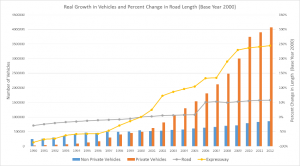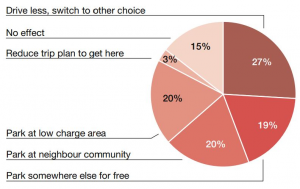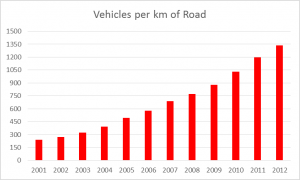 Car owners all over the world know the frustration that parking can cause, but in China where illegal parking is common this frustration extends to other transport users as cars take over sidewalks, pedestrian squares, bike lanes, and even bus stops. With the number of private vehicles growing from less than 10 million in 2002 to over 88 million in 2012, the number of drivers and demand for good parking spaces continue to grow. In China parking management systems have been unable to keep up, leading to chaotic parking situations which cause congestion, increase air pollution and decrease the economic efficiency of the city. Improving the parking management system is a challenging task that Chinese cities have little experience with and an area where GIZ is able to offer its expertise. Working with Beijing and Shenzhen, GIZ has helped to address the short term need for available parking spaces to reduce Vehicle Kilometers Travelled (VKT) while using parking as a Transport Demand Management (TDM) tool to reduce vehicle trips in the long term.
Car owners all over the world know the frustration that parking can cause, but in China where illegal parking is common this frustration extends to other transport users as cars take over sidewalks, pedestrian squares, bike lanes, and even bus stops. With the number of private vehicles growing from less than 10 million in 2002 to over 88 million in 2012, the number of drivers and demand for good parking spaces continue to grow. In China parking management systems have been unable to keep up, leading to chaotic parking situations which cause congestion, increase air pollution and decrease the economic efficiency of the city. Improving the parking management system is a challenging task that Chinese cities have little experience with and an area where GIZ is able to offer its expertise. Working with Beijing and Shenzhen, GIZ has helped to address the short term need for available parking spaces to reduce Vehicle Kilometers Travelled (VKT) while using parking as a Transport Demand Management (TDM) tool to reduce vehicle trips in the long term.

Figure 1- Graph showing real growth in number of vehicles and percent change in road length (base year 2000) in Beijing (1990-2012) – Multiple Statistical Yearbooks
Parking Situation in Chinese Cities
Despite the rapid growth of vehicles in Chinese megacities, the real challenge has come from poorly managing existing parking rather than from a shortage of parking infrastructure. Parking in China has been handled with inadequate pricing, poor enforcement, no clear strategy, little planning, and ineffective management structure. In many cities off-street parking is sufficiently available, but priced higher than curbside parking. This leads to increasing traffic as people drive around trying to locate a lower priced or even free on-street parking space. Consequently, the additional vehicles on the road are emitting air pollutants and greenhouse gas emissions adding to both local and global pollution challenges.
Curbside parking that is free or underpriced has been found to increase congestion with a review of international studies (Link) finding that on average 30 % of cars in central business districts are looking for parking spaces. The price of parking is set by the local transport bureau which uses a single rate for each type of parking independent of its location. This causes parking to be underpriced in downtown areas with high demand, which increases congestion as motorists drive around looking for a spot. Between 2002 and 2009 Beijing priced all residential curbside parking at 0.5 RMB/hr, while residential parking garages were priced at 2 RMB/hr, incentivising residents to use curbside parking space for long-term parking. With curbside parking free or underpriced, many expensive parking garages sit empty even as they could meet the parking demand for the area and reduce the amount of traffic. In central Shanghai’s People Square underground parking garage with 600 spaces, only 20% of spaces are utilised during peak hours because the area has many underpriced on-street parking spaces.
In addition, parking can affect other modes of transport as the lack of parking management and poor enforcement leads to parking in bike lanes, on sidewalks and at bus stops. Parked cars on sidewalks often cause pedestrian traffic jams while bike lanes full of cars make cycling less safe by forcing cyclists into the street. These problems are caused by weak enforcement of illegal parking which is charged to municipal police who see parking as a low priority and often delegate the task to traffic wardens with limited staff and technology.
With little experience in managing parking and entrenched interests benefiting from the existing parking regime, improving parking management will not be an easy task for many cities. Better management would help bring in new revenue to fund public and non-motorised transport systems and shift benefits toward more sustainable transport options. Moreover, better parking policies and improved management would help reduce the negative impacts that a personal vehicle based system has on sustainability and economic efficiency in Chinese cities.
Improving the Parking Situation in Chinese Cities
Finding additional space in China’s already dense cities to build more parking is challenging, expensive and would not deal with the fundamental problem of poorly managed parking. To address the parking challenge, cities will need to improve the management of existing parking by enforcing illegal parking, creating different parking zones, adopting new technologies and adjusting parking prices. This is a challenging task for Chinese cities which have little experience in parking management and an area where GIZ has been able to help.
Beijing: Parking Price Reforms and Parking Zones
In 2011, the Beijing Municipal Government designed TDM policies, which could help reduce private vehicle trips while promoting public and non-motorised transport. These policies were particularly important because Beijing had just seen 750,000 private vehicles purchased in 2010 ahead of the government’s license plate restriction which came into effect at the beginning of 2011. This growth of private vehicles had greatly added to the congestion and air pollution with all these new drivers looking to join the ranks of commuters.
Supported by GIZ, the Beijing Municipal Government developed differential parking pricing by creating three different zones within the city, based on the traffic congestion in the area. The most expensive zone to park was within the 3rd ring road and other busy commercial areas within the city. The next zone was all other areas within the 5th ring road which was less expensive and the cheapest parking was outside the 5th ring road. On-street parking is also priced higher than off-street parking where ground level is more expensive than underground parking. To encourage vehicle turnover in dense commercial areas, on-street parking is priced at 5RMB per half hour but increases by 50% after the first hour. In addition to raising prices, parking fees in residential neighborhoods and during the night are kept low to meet resident’s needs.

Figure 2- Survey on Effects of Area Differential Parking in Beijing – Beijing Transport Research Center
The program was successful and results could be seen three months after implementation with a 12% less vehicles parking in on-road parking spots and 19% less in off-road parking which helped free up spaces and reduce VKT as well as vehicle trips. This lead to a 12% decrease in the monitored traffic flow around parking areas and a survey of drivers found that 27% drove less or switched to another mode of transport. These results are encouraging but problems still remain in illegal parking enforcement and in the collection of parking fees, as only half of parking fees charged are received by the government in Beijing (Link). As new parking technology becomes available and the government looks to reduce congestion, additional parking measure will be needed in Beijing to continue to improve the situation.
Shenzhen: Piloting New Policies and Incorporating Constructive Feedback
In February 2014 GIZ brought in international experts to help evaluate Shenzhen’s new pilot parking management plan. As part of this program Shenzhen started to pilot the collection of parking fees at 1,673 roadside spots in July with plans to expand to 45,000 by the end of 2015. The price of parking will be based on location with rates as high as 160 RMB for a full workday. The revenue will be collected through a branch of the municipal government to avoid the loss in revenue that was documented in Beijing and Shanghai where fee collection was contracted to an outside company (Link). The government is working on making it easy to pay for parking through popular apps such as WeChat and Alipay (Link) and connecting the parking system with people’s mobile phones to give them notice before time expires.

Figure 3- Number of Motor Vehicles per 1km of Road in Shenzhen (2001-2012) – Multiple Statistical Yearbooks
The new parking regulations and management system is being implemented slowly first in pilot areas before being moved to other parts of the city. The full plan is estimated take 330,000 vehicles off the road and increase public transit ridership by an additional 1 million trips per day (Link). Because of this large impact on the urban transport system, GIZ is evaluating the plans and helped Shenzhen’s Municipal Commission on Transport (MCT) to hold two public hearings in August and October 2014 to get feedback on the proposed changes. The hearings were attended by representatives, reporters and media channels representing different interests. From these hearings and public opinions collected since July 2014 the MCT was able to put together four main recommendations;
- Optimize the legislation system and create legal protection for adjusting parking fees- A legal protection helps ensure that future changes in the parking system are in line with the cities objectives for road transport management.
- The implementation and adjustment of fees should be careful, appropriate and steady- This will help protect the interest of different groups of people that will be affected by changes in parking policy.
- Research on road adjustment fee’s should start right away- Because these policies will have an impact on many different groups and public opinion is hard to predict, it is recommended that research on the policies gets started right away.
- Comprehensive and integrated policies are needed for congestion mitigation- Parking policy will not be enough and other policies such as congestion charge, improved traffic enforcement and public transport prioritization should also be considered.
From Freeing up Parking Spaces to Transport Demand Management
When addressing parking in Chinese cities the first step is to manage and price it right to ensure drivers are able to find a parking spot. Dealing with this challenge which includes higher on-street parking price, getting rid of free parking in central locations and better enforcement of illegal parking can help open up more parking spaces. This will reduce congestion and speed up traffic flows as drivers are easily available to find suitable parking spaces.
To address long term challenges of reducing air pollution, traffic accidents and greenhouse gas emissions, parking can serve as an effective TDM measure to reduce VKT and vehicle trips. These possibilities can be seen in Shenzhen where parking policies are expected to take 330,000 vehicles off the road a day which will have a huge impact on sustainability. As Chinese cities look for ways to control the amount of vehicles they should consider parking in addition to other TDM strategies. In many cases parking is less disruptive, easier to adjust and can bring in more revenue. GIZ will continue to partner with Chinese cities to both improve the current parking situation and develop other effective TDM strategies to put them on a sustainable path.
Resources:
GIZ Beijing TDM Project
ITDP Parking Guide for Chinese Cities
ADB Parking Policy in Asian Cities


